jjsjigs
Banned
Here's the deal-e-o folks. Tube flies are lethal on trout, bass, steelies... they have quite a following in the Steelhead crowd. However they are expensive to purchase (the tubes, the weights, etc, etc.). Plus, usually tube flies are reserved for "fly guys". I've adapted a system that makes making tube flies quite easy and inexpensive. The best part is that one may use a flyrod to cast them OR a spin or bait caster. The really cool thing is that you can change up different hooks depending on the fishing conditions and still leave the "tube" on the line so it is cost effective. You normally don't lose the tube when fishing... if you snag, you only lose the hook.
First go to your local market and buy some Q-tip that have a plastic shank (usually they are the "cheaper" off brand Dollar Store type Q-Tips)

Cut the cotton off both ends and leave the plastic shank
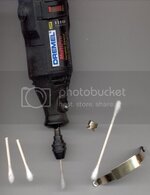
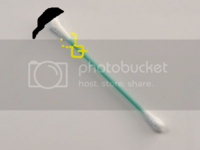
Now your going to have to find a way to mount the q-tip shank to your vise. The easiest way is to clip the eye of a streamer hook off and mount the rest of the hook on your vise. Now thread the q-tip over the shank of the hook.
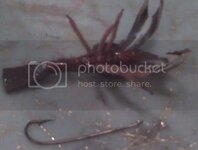
Where the eye of the hook was... take a lighter and melt the end of the Q-tip to create a lip. This will keep the thread from sliding off the tube when you tie and gives it an anchor to whip finish the head of your tube.
Now you can start your thread onto the q-tip shank.
You may create any type of fly by tying whatever materials you wish onto the q-tip shank. Here's a few of my creations I've been playing with:
A zonker tube

A bait fish tube
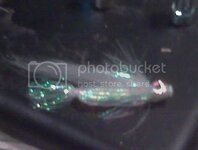
a wooly bugger tube
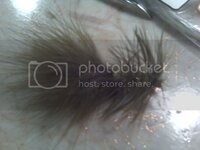
A crayfish tube
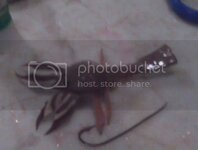
Now you thread your line through the tube:
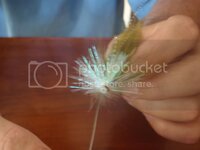
at the rear of the tube fly you tie on a hook of your choice... I tend to use a circle hook but you can use anytype of hook you wish depending on the fishing conditions or species your after. I've tied on trebles, lightwire dry fly hooks for panfish. Salt water hooks (and threadng a steel leader through the tube) for pike and muskie. Big fat Salmon egg hooks for Steelhead. Your limitless on what you can use.

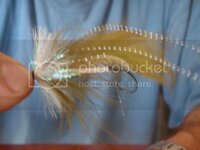
now to cast this monster you need a little weight, especially if your using spin rod. Add a shot above the head of your tube fly.
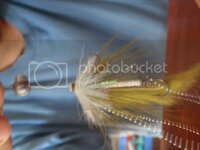
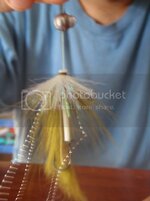
This is what it looks like dry:
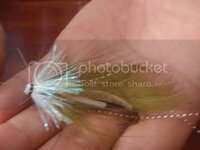
and this is what it looks like wet:
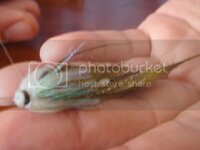
NOTE: I've found that you can paint the plastic tube with Testors Model paint if you don't like standard white, or cover with holographic lure tape, or sharpie marker. Also, you can use soft lead wire to wrap around the tube shank if you don't like using split shot. One may place a faceted bead or another split shot between the tube and the hook to act like a spacer. (and when fishig for Salmon or Steelhead a red, pink, yellow, or orange bead makes a good egg imitation too) The spacer is a good idea between the hook and the tube. This is in-case you lose the hook on a snag, the tube wont' slid off. I've fished with the same tube for multiple fishing outings and have only lost a few hooks. So your saving some money by making these instead of losing 4 or 5 jigs, X-raps, or $7 dollar Rapala's when fishing in rocky or weed filled areas. A box of Q-tips is a cheap investment for $1.50!!! Plus at Wal-Mart you can buy a box of 25 circle hooks for .85 cents. If you already have tying materials... your ahead of the game. So for $2.35 you can make over 100 tubes and keep you fishing longer!
First go to your local market and buy some Q-tip that have a plastic shank (usually they are the "cheaper" off brand Dollar Store type Q-Tips)

Cut the cotton off both ends and leave the plastic shank


Now your going to have to find a way to mount the q-tip shank to your vise. The easiest way is to clip the eye of a streamer hook off and mount the rest of the hook on your vise. Now thread the q-tip over the shank of the hook.

Where the eye of the hook was... take a lighter and melt the end of the Q-tip to create a lip. This will keep the thread from sliding off the tube when you tie and gives it an anchor to whip finish the head of your tube.
Now you can start your thread onto the q-tip shank.
You may create any type of fly by tying whatever materials you wish onto the q-tip shank. Here's a few of my creations I've been playing with:
A zonker tube

A bait fish tube

a wooly bugger tube

A crayfish tube

Now you thread your line through the tube:

at the rear of the tube fly you tie on a hook of your choice... I tend to use a circle hook but you can use anytype of hook you wish depending on the fishing conditions or species your after. I've tied on trebles, lightwire dry fly hooks for panfish. Salt water hooks (and threadng a steel leader through the tube) for pike and muskie. Big fat Salmon egg hooks for Steelhead. Your limitless on what you can use.


now to cast this monster you need a little weight, especially if your using spin rod. Add a shot above the head of your tube fly.


This is what it looks like dry:

and this is what it looks like wet:

NOTE: I've found that you can paint the plastic tube with Testors Model paint if you don't like standard white, or cover with holographic lure tape, or sharpie marker. Also, you can use soft lead wire to wrap around the tube shank if you don't like using split shot. One may place a faceted bead or another split shot between the tube and the hook to act like a spacer. (and when fishig for Salmon or Steelhead a red, pink, yellow, or orange bead makes a good egg imitation too) The spacer is a good idea between the hook and the tube. This is in-case you lose the hook on a snag, the tube wont' slid off. I've fished with the same tube for multiple fishing outings and have only lost a few hooks. So your saving some money by making these instead of losing 4 or 5 jigs, X-raps, or $7 dollar Rapala's when fishing in rocky or weed filled areas. A box of Q-tips is a cheap investment for $1.50!!! Plus at Wal-Mart you can buy a box of 25 circle hooks for .85 cents. If you already have tying materials... your ahead of the game. So for $2.35 you can make over 100 tubes and keep you fishing longer!
